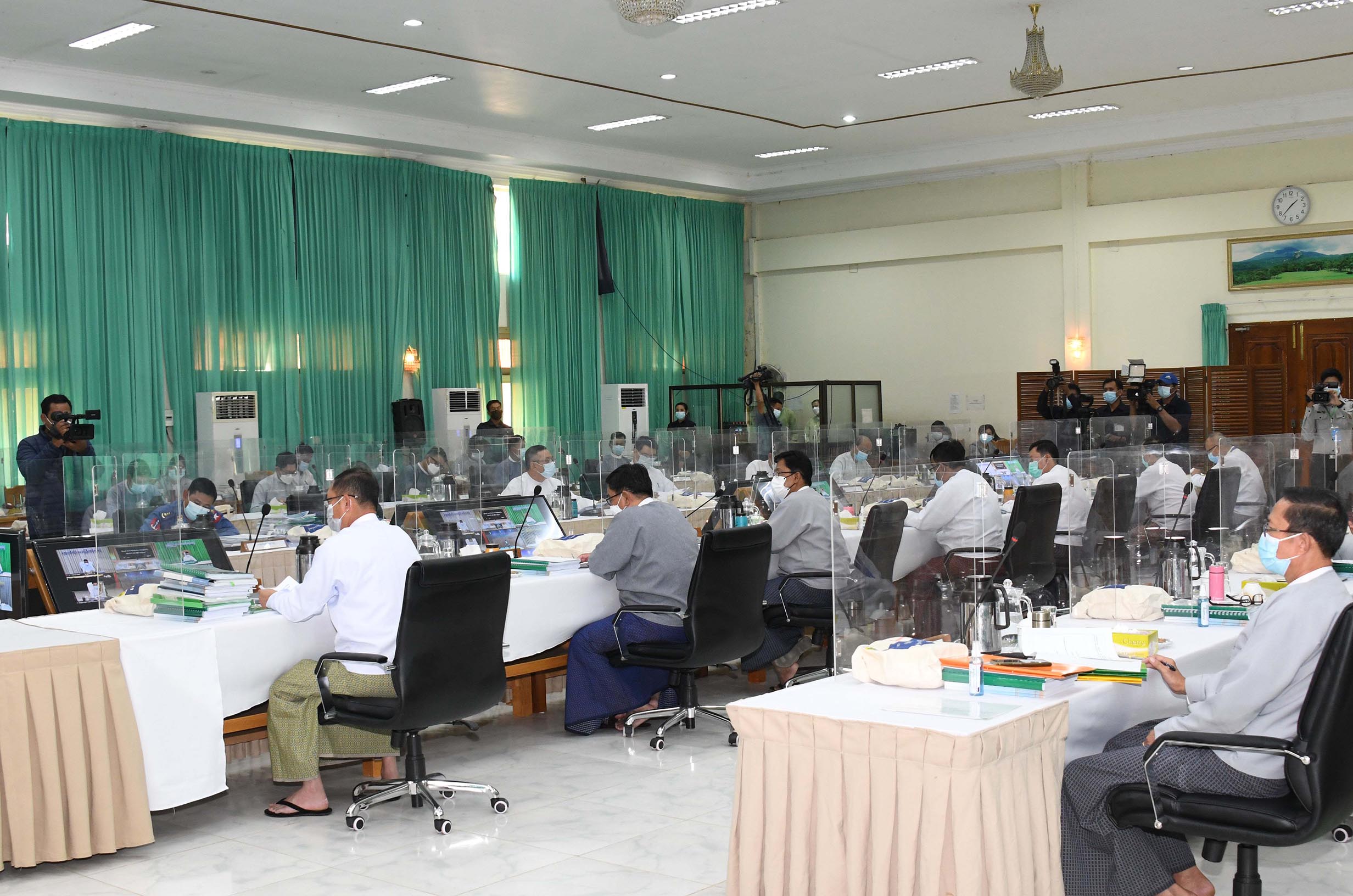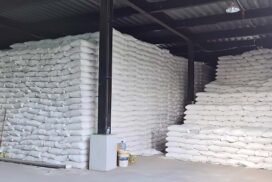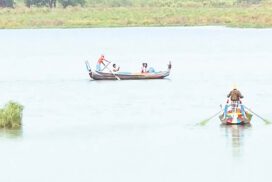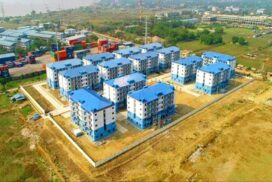State Administration Council Vice-Chairman Deputy Prime Minister Vice-Senior General Soe Win delivered a remark at the second meeting of the National-Level Central Committee on Administration and Management of Natural Resources in Coastal Areas, held in the afternoon of 16 February at Ingyin Hall of the Forest Department under the Ministry of Natural Resources and Environmental Conservation in Nay Pyi Taw.
Present at the meeting were Union Minister U Tin Htut Oo for Agriculture, Livestock and Irrigation, Union Minister U Khin Maung Yi for Natural Resources and Environmental Conservation, Deputy Ministers U San Lwin and U Min Min Oo, the Commodore General Staff (Navy), permanent secretaries and officials concerned. Also, the chief ministers of the regions and states and officials virtually attended the meeting.
At the meeting, the chairman of the central committee stated that natural resources and environmental conservation are regarded as the State responsibility and the government is prioritizing this matter. By looking forward to achieving the State’s coastal and mangroves sectoral management activities, according to the SAC Notification No 95/2021 dated 2 April 2021, the National-Level Central Committee on Administration and Management of Natural Resources in Coastal Areas was formed. It was reconstituted on 30 October 2021 under the Notification 306/2021 with 21 members and 10 responsibilities.
At the first meeting of the committee held on 9 June 2021, 11 points of decisions regarding the administration and management of the coastal areas were made under the guidance of the SAC depending on the reports and discussions of the committee members.
The central committee planned to hold the meeting biannually. Therefore, he asked the committee members to report the implementation of the 11 points of the decision made in the first meeting and the future tasks and processes to implement effectively the coastal area management activities.
The coastal area conservation plays a pivotal role in the sustainable development of the country and sustainable natural resources conservation for future generations is a key aspect of the State, he stated.
Myanmar’s coastal resources can meet the goals and objectives of the different sectors. It helps contribute to the sustainable development of the State. To enhance the multi-sectoral coordination, the national-level committees was formed as well. Of the 10 responsibilities of the central committee, as per the task (C), developing the national-level Integrated Coastal Management Programme (ICM) and instructions to implement the projects of ICM are assigned to the committee. According to point (B) of the decision made by the central committee at its first meeting, all the central committee departments must exert concerted efforts to implement the ICM.
Under the ICM programme, Myanmar coastal areas and marine resources must be valued as the country’s natural resources. All the stakeholders must exert concerted efforts to balance the conservation and development focuses, building resilience on human-environmental impacts and utilizing effectively for the long-term sustainable development for future generations.
According to the United Nations Conference on Environment and Development (UNCED) 1992, the ICM system was reflected by the fundamental principles on the environment and development which revealed the principle of intergenerational equality, the principle of environmental protection and the principle of environmental compensation.
This ICM system is the coherent implementation of the environmental sustainability, integrated management approach on natural resources among the relevant sectors and analysis to ensure the coherence for the ecosystem in the mineral extraction and the development activities.
It is the environmental management with advanced practices in the forms of social, economic and environmental elements, he remarked.
Whichever business executions in coastal areas affect the ecosystem and those engaged in natural resource extraction. Biodiversity is in ecological diversity in coastal areas. Loss of biodiversity can affect the ecosystem. This being so, the values of the elements of the coastal ecosystem must be carefully realized in the development activities and specific measures have to be taken to protect the environment.
As a result of this, we must consider the impacts on coastal regions and socio-economy by the agriculture, fisheries, hotels and tourism, natural gas, petroleum and mineral extraction, manufacturing and construction enterprises. Furthermore, the issues between the stakeholders must be addressed concertedly by looking forward to the long-term benefits of the State and the people. The system also coordinates the stakeholders from the multi-sectors, stressed the Vice-Senior General.
A draft for ICM, with the technical assistance of the International Union for Conservation of Nature (IUCN), and the future tasks will be reported hereby.
Under the ICM programme, Myanmar coastal areas and marine resources must be valued as the country’s natural resources. All the stakeholders must exert concerted efforts to balance the conservation and development focuses, building resilience on human-environmental impacts and utilizing effectively for the long-term sustainable development for future generations. The six strategies of ICM are administration and management, organizational capacity development, coastal ecosystem conservation and restoration, research and supervision, the delegation of administration, private partnership with the responsible businesses.
The ICM programme is drawn up for a 15-year period. The relevant departments must draw plans to implement those six strategies. Those plans will be funded by the State and the development partners of the State. The committee members must cooperate effectively in all the tasks.
Myanmar has rich marine biodiversity and long coastal regions. The resources help contribute to the country’s food security and sustainable development. The growth in population along with the coastal areas, the deforestation and mangroves destruction, overfishing, environmental impacts from the coastal tourism and development projects, pollution in the marine ecosystem due to the mineral extraction and water depletion issues must be resolved in harmony.
Harmony with environmental must be adopted to deal with the growing population and changes in living styles in order to achieve sustainable development.
The members of the United Nations are trying to achieve the UN’s Sustainable Development Goals. Coastal marine development is one of the SDGs.
Global warming, global sea-level rise and climate change challenges must also be considered while developing the ICM projects.
To mitigate climate change and the greenhouse impacts, the mangroves, coastal areas and marine ecosystems being the carbon sink can be defined as the blue carbon initiative. The conservation activities are therefore required to be undertaken across the globe.
The mangrove destruction can cause climate change, riverbank erosion and a threat to marine biodiversity. Therefore, The establishment and protection of mangroves and green building concepts are system-wide approaches to climate change. Coastal and marine tourism, inshore and offshore fishing, the onshore and offshore exploration and drilling are regarded as “Blue Economy”. the sustainable use of ocean resources for the economy is crucial in the Sustainable Blue Economy Initiative which integrates sustainable development and green growth. The Wildlife Conservation Society (WCS Myanmar) reported four opportunities from the Blue Economy Initiative in 2015; developing the policy and frameworks for the administration and management of the coastal and marine business sectors, investment in coastal and marine extraction, prospects on conservation activities for rich biodiversity, and the protection of mangroves for natural disasters resilient measures under the environmental security and protection enhancement plan.
Myanmar is cooperating with the international countries to carry out coastal and marine sustainable activities as the UN’s 14 SDGs.
The effective implementation for the coastal development in the post-COVID-19 pandemic are encouraged and Myanmar will conduct the ICM by looking forward to the enhancement of the Blue Economy Initiative.
He also appreciated the implementation and efforts of the central committee for the points of decisions made in the first meeting. Reviving the coastal and marine conservation and development activities suspended by the pandemic, coordination in each sector, the existing development activities and future plans in harmony with the coastal and marine sustainability can be discussed openly, he pointed out.
Later, a coastal risk awareness video was shown. The secretary of the central committee, Director-General U Htay Aung of the Forest Department reported the accomplished tasks and preparations to draw up the ICM.
Next, other committee members also explained matters in each sector and the Deputy Prime Minister instructed them to fulfil the needs. Then, the Deputy Prime Minister concluded the meeting with the closing remarks. — MNA














